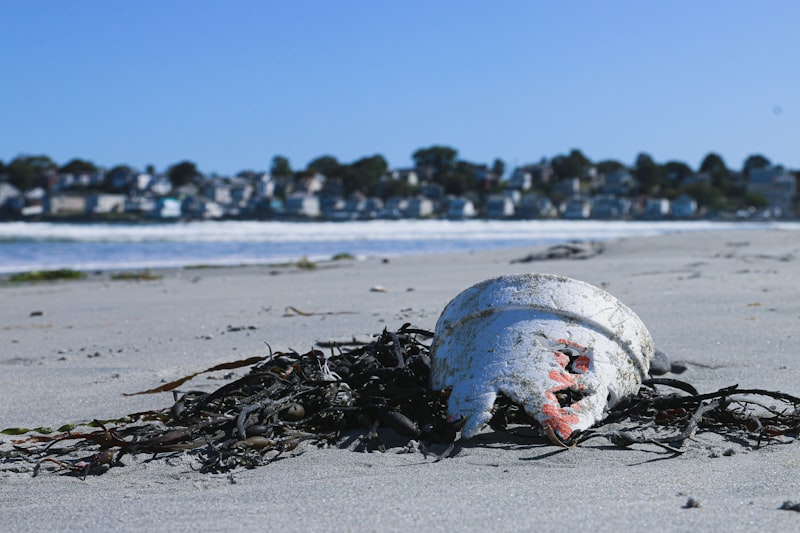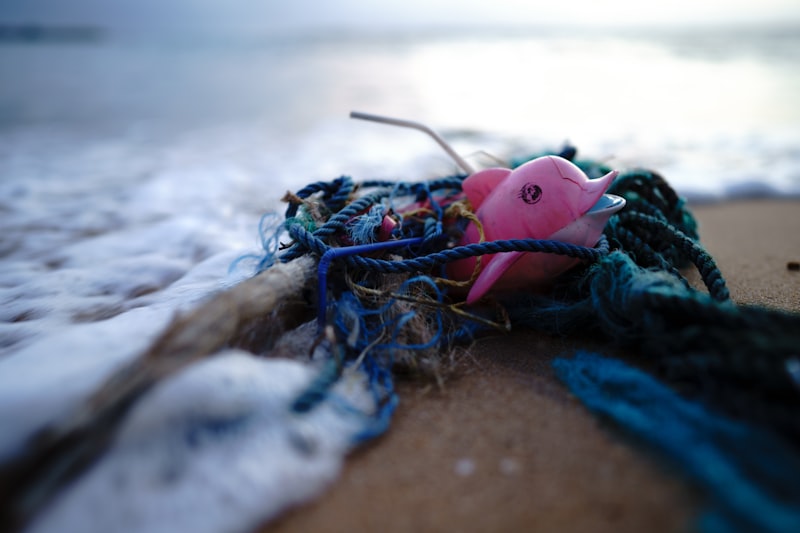Plastic, with its durability and versatility, has become a ubiquitous part of modern life. Yet, its convenience comes at a staggering cost to marine animals. Discarded plastic items, from bottles to microplastics, find their way into the sea, where they persist for centuries. Marine organisms, mistaking plastic for food or becoming entangled in it, suffer grievously. Sea turtles, for instance, often ingest plastic bags, mistaking them for jellyfish, a staple in their diet. This ingestion can lead to suffocation, starvation, or internal injuries.
Moreover, plastic debris acts as a vehicle for transporting invasive species and harmful pollutants across vast distances. Chemicals leaching from plastics into the water can disrupt endocrine systems in marine life, affecting reproduction and growth. These pollutants accumulate up the food chain, ultimately impacting human health when seafood contaminated with microplastics is consumed.
Efforts to mitigate plastic pollution are underway globally, yet the scale of the problem demands urgent action. Innovations in biodegradable materials and recycling technologies offer hope for a sustainable future. However, individual actions also play a crucial role. Simple changes in consumer habits, such as reducing single-use plastics and supporting beach clean-ups, can collectively make a significant impact.
The battle against plastic pollution is one that requires concerted efforts from governments, industries, and individuals alike. By raising awareness, implementing effective policies, and embracing sustainable practices, we can safeguard our oceans and the magnificent creatures that call them home.
Ocean’s Silent Crisis: How Plastic Pollution Threatens Marine Life
Imagine standing on the shore, gazing out at the vast expanse of the ocean. It’s serene, captivating, and seemingly untouched by human hands. Yet beneath the surface lies a silent crisis that imperils marine life like never before: plastic pollution.
Plastic, once hailed as a miracle material for its versatility and durability, has now become one of the ocean’s greatest adversaries. From discarded bottles to abandoned fishing nets, our oceans are drowning in plastic waste. Every year, millions of tons of plastic enter the ocean, with devastating consequences for marine ecosystems.
Sea turtles mistake plastic bags for jellyfish, a staple in their diet. Dolphins and seals become entangled in fishing lines and nets, struggling to break free or succumbing to exhaustion. Microplastics, tiny fragments of degraded plastic, infiltrate every level of the marine food web, from plankton to whales, posing a toxic threat to marine life.
The impact of plastic pollution reverberates across the entire ocean ecosystem. Coral reefs, vital nurseries of marine biodiversity, face smothering from plastic debris, hindering their ability to thrive. Birds, such as albatrosses and seabirds, unknowingly feed plastic to their chicks, leading to starvation and reduced reproductive success.
As plastics break down into smaller particles, they release harmful chemicals and absorb pollutants from the surrounding seawater. These toxins accumulate in the tissues of marine organisms, potentially entering the human food chain through seafood consumption.
Efforts to combat plastic pollution are underway, with initiatives ranging from beach clean-ups to global agreements on reducing plastic waste. Innovations in biodegradable plastics and recycling technologies offer hope for a future where our oceans are cleaner and healthier.
Yet, the battle against plastic pollution requires collective action and global cooperation. We all have a role to play, from reducing our use of single-use plastics to supporting policies that promote sustainable alternatives. Together, we can turn the tide on this silent crisis and safeguard the future of our oceans and marine life.
From Sea to Shining Sea: Plastic Pollution’s Devastating Toll on Marine Ecosystems
In the depths of the ocean, where sunlight struggles to penetrate, plastic debris disrupts the delicate balance of life. Marine creatures mistake plastic for food, leading to ingestion and often fatal consequences. Seabirds, relying on the ocean for sustenance, inadvertently feed their chicks plastic instead of nourishing prey. The consequences ripple through the food chain, endangering entire ecosystems.
Coastal regions, once pristine, now bear the brunt of humanity’s plastic consumption. Beaches once celebrated for their beauty now host a tragic mosaic of plastic debris, each fragment a testament to our disregard for the environment. With each tide, more plastic washes ashore, embedding itself in the sand like a persistent reminder of our impact.
Rivers, the lifeblood of civilizations, carry plastic waste from inland to the seas, exacerbating the problem. Plastic pollution knows no bounds, infiltrating even remote and seemingly untouched corners of the globe. Its persistence is matched only by its ubiquity, posing a monumental challenge to conservation efforts worldwide.
Efforts to mitigate plastic pollution range from community clean-ups to global policy initiatives. Recycling, reducing single-use plastics, and promoting eco-friendly alternatives are steps towards a sustainable future. Yet, the battle against plastic pollution requires collective action and unwavering commitment to protect our oceans, from sea to shining sea.
Unseen Victims: Plastic Pollution’s Stealthy Assault on Marine Wildlife
The problem lies not only in the visibility of plastic pollution but also in its insidious impact on marine ecosystems. From microscopic plankton to majestic whales, marine wildlife encounters and ingests plastic particles of all sizes. These encounters often prove fatal, as plastics can obstruct digestive tracts, causing starvation, or release toxic chemicals that permeate entire food chains.

Plastic pollution’s stealthy assault extends beyond direct ingestion. Lost or discarded fishing gear, known as ghost nets, continue to trap marine life indiscriminately long after they are abandoned. Imagine a delicate coral reef ensnared in abandoned fishing gear, slowly suffocating under the weight of human negligence.
Yet, amidst the dire consequences, there is hope. Awareness campaigns and conservation efforts are gaining momentum worldwide, aiming to reduce plastic consumption, improve waste management, and clean up our oceans. Governments, industries, and individuals are increasingly recognizing the urgency of the situation, striving to innovate and implement solutions that safeguard marine habitats for future generations.
As we confront this invisible enemy, each of us plays a pivotal role. By reducing single-use plastics, supporting sustainable practices, and advocating for policy changes, we can collectively mitigate plastic pollution’s devastating impact on marine wildlife. Together, we can ensure that our oceans remain vibrant and resilient ecosystems, free from the silent threat of plastic pollution.
The Plastics Paradox: How Convenience is Costing Marine Life
Imagine this: you buy a takeaway lunch, complete with a plastic fork, spoon, and container. Once you’re done, you dispose of these items, perhaps without a second thought. But where do they end up? Many of these plastics find their way into our oceans through improper disposal or inadequate recycling. This sets off a chain reaction that impacts marine ecosystems in profound ways.
Plastics do not biodegrade like organic materials. Instead, they break down into smaller fragments known as microplastics, which can persist in the environment for hundreds of years. Marine animals often mistake these tiny pieces for food, ingesting them accidentally. This ingestion can lead to internal injuries, digestive blockages, and even starvation. The consequences ripple through the food chain, ultimately affecting human health as well.
The Great Pacific Garbage Patch, a vast area of marine debris, serves as a poignant symbol of our plastic consumption. This floating mass, primarily composed of plastics, highlights the scale of the issue. It’s a stark reminder that our convenience-driven lifestyle has consequences far beyond our immediate surroundings.
What can we do to address this crisis? It starts with awareness and responsible consumption. Opt for reusable alternatives whenever possible. Bring your own bags to the grocery store, choose products with minimal packaging, and support businesses committed to reducing plastic waste. Every small action adds up to make a significant difference.
Together, we can break free from the plastics paradox and pave the way for a cleaner, healthier ocean ecosystem. Let’s rethink convenience and prioritize sustainability for the sake of our planet and the marine life that calls it home.
Beyond the Surface: Exploring the Deep Impact of Plastic Pollution on Marine Habitats
Imagine a sea turtle mistaking a plastic bag for a jellyfish, or seabirds unknowingly feeding their chicks plastic pellets instead of nutritious fish. These scenarios, tragically common today, highlight the insidious nature of plastic pollution. As non-biodegradable materials persist for centuries, they break down into microplastics that infiltrate every level of the marine food chain, from plankton to whales.
The impact extends beyond aesthetics; it disrupts reproductive cycles, alters behaviors, and even introduces toxic chemicals into marine organisms. Coral reefs, vibrant hubs of oceanic biodiversity, face smothering from plastic debris, hindering their ability to regenerate and support marine life. The consequences ripple outward, affecting coastal communities reliant on fisheries for sustenance and livelihoods.

Efforts to mitigate this crisis are underway, from grassroots beach clean-ups to global initiatives banning single-use plastics. Yet, the scale of the problem demands collective action and innovation. Can we innovate biodegradable alternatives that mimic plastic’s convenience without its enduring harm? Will policy changes and consumer awareness drive a shift towards sustainable practices?
In confronting the deep impact of plastic pollution on marine habitats, we face a pivotal moment. Each discarded bottle or abandoned fishing net holds the potential to rewrite the future of our oceans. As stewards of this planet, the choices we make today will resonate far beneath the waves, shaping the legacy we leave for generations to come.
Underwater Menace: Plastic Pollution’s Alarming Effects on Marine Food Chains
Plastic pollution poses a grave threat to marine food chains, disrupting the natural order in profound ways. Imagine a sea turtle mistaking a floating plastic bag for a jellyfish, its staple diet. The ingestion of such indigestible debris can lead to blockages, malnutrition, and even death. These majestic creatures, along with dolphins, whales, and seabirds, suffer immensely from entanglement in plastic debris, often leading to suffocation or severe injuries.
But the impact goes deeper. Microplastics, tiny fragments less than 5 millimeters in size, pervade the ocean waters, entering the food chain at its most foundational levels. Plankton, the microscopic organisms that form the basis of marine food webs, ingest these particles. As larger marine organisms consume contaminated prey, the concentration of toxic substances within their bodies magnifies, posing risks to their health and survival.
Rhetorical question: Can we afford to stand idly by as our oceans suffocate under the weight of plastic waste?
The ramifications extend beyond individual species. Entire ecosystems face destabilization as plastic pollution alters predator-prey dynamics and nutrient cycling. Coral reefs, vital hubs of biodiversity, face threats from plastic entanglement and the smothering effect of debris, jeopardizing their ability to support marine life.
Metaphor: Plastic pollution is akin to a sinister shadow creeping across the ocean floor, threatening to snuff out the vibrant life that depends on these waters.
As stewards of the Earth, it falls upon us to act. By reducing plastic consumption, recycling diligently, and supporting initiatives for clean oceans, we can mitigate this crisis. Together, we can ensure that future generations inherit seas teeming with life, not drowning in plastic.
SOS from the Seas: Urgent Calls to Combat Plastic Pollution Threatening Marine Life
In the vast expanse of our oceans, a silent crisis is unfolding—a relentless onslaught of plastic pollution that threatens marine life at an alarming rate. Imagine a sea turtle ensnared in discarded fishing nets or a seabird mistaking a floating plastic bottle for food. These heartbreaking scenes are not just isolated incidents but stark reminders of the urgent need to address plastic pollution.
Plastic, once hailed as a marvel of modern convenience, has now become a pervasive threat to our marine ecosystems. Every year, millions of tons of plastic waste find their way into the oceans, where they persist for centuries, breaking down into smaller microplastics that infiltrate every level of the marine food chain.
The consequences are dire. Marine animals ingest or become entangled in plastic debris, leading to injury, suffocation, and starvation. Coral reefs, vital nurseries of the sea, suffer as plastic smothers and breaks apart their delicate structures. The very lifeblood of our planet’s oceans is being choked by our reliance on single-use plastics.
Yet, amidst this crisis, there is hope. Across the globe, individuals, communities, and governments are taking action. From beach clean-ups to bans on plastic bags and straws, awareness is growing, and initiatives are multiplying. Companies are innovating with biodegradable alternatives, and scientists are researching new ways to remove existing plastic waste from the oceans.
The battle against plastic pollution is not just about saving marine life; it’s about safeguarding our own future. Every piece of plastic we refuse, reuse, or recycle makes a difference. It’s a choice between a sea choked with plastic or one teeming with life. The time to act is now, before it’s too late for our oceans and the creatures that call them home.
Join the movement. Together, we can turn the tide on plastic pollution and ensure a healthier, cleaner future for our seas and all who depend on them.
This article aims to captivate readers with vivid imagery and a call to action while emphasizing the urgency of addressing plastic pollution in a conversational tone.
Frequently Asked Questions
What initiatives are in place to combat plastic pollution in marine environments?
Learn about the current initiatives aimed at combating plastic pollution in marine environments, focusing on global efforts and local community actions. Discover innovative solutions and collaborative projects working towards reducing plastic waste and safeguarding marine life.
What are the main types of plastic pollution affecting marine life?
Learn about the primary types of plastic pollution that impact marine life, including microplastics, macroplastics, and nurdles. Understand how these pollutants enter oceans, their environmental effects, and global efforts to mitigate their harm.
How can individuals reduce plastic pollution to protect marine life?
Discover effective ways individuals can reduce plastic pollution to safeguard marine life. Learn actionable tips and strategies to minimize plastic waste, ensuring a healthier environment for marine ecosystems.
What are the long-term consequences of plastic pollution in oceans?
Learn about the lasting impacts of plastic pollution in oceans, including threats to marine life, ecosystems, and human health. Understand how plastics break down into microplastics, enter the food chain, and persist for decades, posing environmental challenges globally.
How does plastic pollution harm marine animals and ecosystems?
Learn how plastic pollution adversely affects marine animals and ecosystems, causing entanglement, ingestion of toxic particles, and disrupting habitats. Discover the critical impacts and ecological consequences of plastic waste in oceans.


